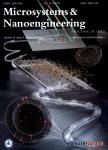Rapid synthesis of transition metal dichalcogenide-carbon aerogel composites for supercapacitor electrodes
作者机构:Department of Chemical EngineeringUniversity of WashingtonSeattleWA 98195-1750USA Department of Materials Science&EngineeringUniversity of WashingtonSeattleWA 98195-2120USA Fundamental&Computational Sciences DirectoratePacific Northwest National LaboratoryRichlandWA 99352USA
出 版 物:《Microsystems & Nanoengineering》 (微系统与纳米工程(英文))
年 卷 期:2017年第3卷第1期
页 面:212-220页
核心收录:
学科分类:08[工学] 0805[工学-材料科学与工程(可授工学、理学学位)] 080502[工学-材料学]
基 金:support from a graduate fellowship from the University of Washington's Clean Energy Institute
主 题:aerogel molybdenum disulfide nanomanufacturing rapid resorcinol-formaldehyde supercapacitor transition metal dichalcogenide tungsten disulfide
摘 要:Transition metal dichalcogenide(TMD)materials have recently demonstrated exceptional supercapacitor properties after conversion to a metallic phase,which increases the conductivity of the ***,freestanding,exfoliated transition metal dichalcogenide films exhibit surface areas far below their theoretical maximum(1.2%),can fail during electrochemical operation due to poor mechanical properties,and often require pyrophoric chemicals to *** the other hand,pyrolyzed carbon aerogels exhibit extraordinary specific surface areas for double layer capacitance,high conductivity,and a strong mechanical network of covalent chemical *** this paper,we demonstrate the scalable,rapid nanomanufacturing of TMD(MoS2 and WS2)and carbon aerogel composites,favoring liquid-phase exfoliation to avoid pyrophoric *** aerogel matrix support enhances conductivity of the composite and the synthesis can complete in 30 *** find that the addition of transition metal dichalcogenides does not impact the structure of the aerogel,which maintains a high specific surface area up to 620 m^(2) g−1 with peak pore radii of 10 *** supercapacitor tests of the aerogels yield capacitances around 80 F g^(−1) at the lowest applied currents,the aerogels loaded with TMD’s exhibit volumetric capacitances up to 127% greater than the unloaded *** addition,the WS2 aerogels show excellent cycling stability with no capacitance loss over 2000 cycles,as well as markedly better rate capability and lower charge transfer resistance compared to their MoS2-loaded *** hypothesize that these differences in performance stem from differences in contact resistance and in the favorability of ion adsorption on the chalcogenides.




